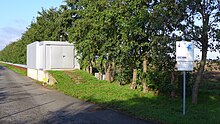GEO600
 |
|
| Organisation |
LIGO Scientific Collaboration |
|---|---|
| Location(s) |
Sarstedt |
| Coordinates | 52°14′49″N 9°48′30″E / 52.2469°N 9.8083°ECoordinates: 52°14′49″N 9°48′30″E / 52.2469°N 9.8083°E |
| Wavelength | 43–10000 km (30–7000 Hz) |
| Built | 1995 |
| Telescope style |
Michelson interferometer, gravitational-wave detector |
| Diameter | 600 m (1,968 ft 6 in) |
| Website | www |
|
|
|
|
[]
|
|
GEO600 is a gravitational wave detector located near Sarstedt in the South of Hanover, Germany. It is designed and operated by scientists from the Max Planck Institute for Gravitational Physics, Max Planck Institute of Quantum Optics and the Leibniz Universität Hannover, along with University of Glasgow, University of Birmingham and Cardiff University in the United Kingdom, and is funded by the Max Planck Society and the Science and Technology Facilities Council (STFC). GEO600 is part of a worldwide network of gravitational wave detectors. This instrument, and its sister interferometric detectors, when operational, are some of the most sensitive gravitational wave detectors ever designed. They are designed to detect relative changes in distance of the order of 10−21, about the size of a single atom compared to the distance from the Sun to the Earth. GEO600 is capable of detecting gravitational waves in the frequency range 50 Hz to 1.5 kHz. Construction on the project began in 1995.
In the 1970s, two groups in Europe, one led by Heinz Billing in Germany and one led by Ronald Drever in UK, initiated investigations into laser-interferometric gravitational wave detection. In 1975 the Max Planck Institute for Astrophysics in Munich started with a prototype of 3 m armlength, which later (1983), at the Max Planck Institute of Quantum Optics (MPQ) in Garching, led to a prototype with 30 m armlength. In 1977 the Department of Physics and Astronomy of the University of Glasgow began similar investigations, and in 1980 started operation of a 10 m prototype.
...
Wikipedia
